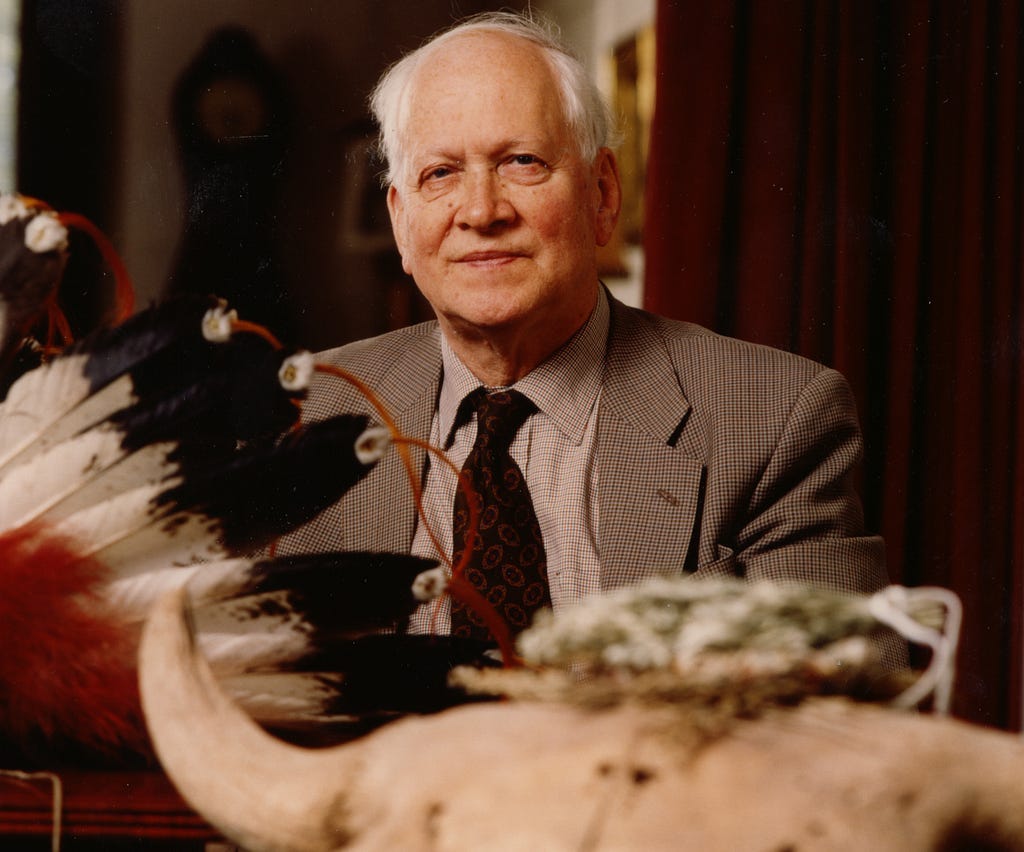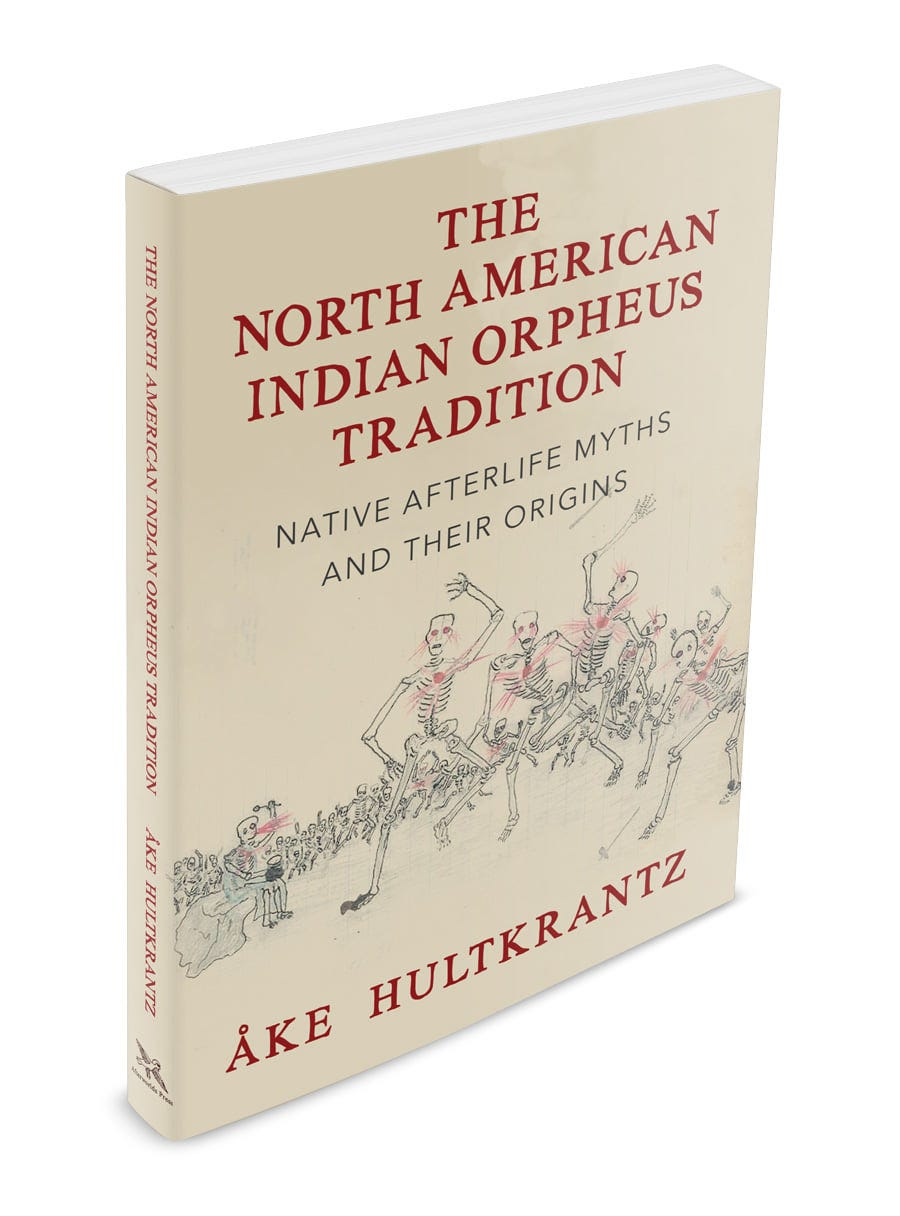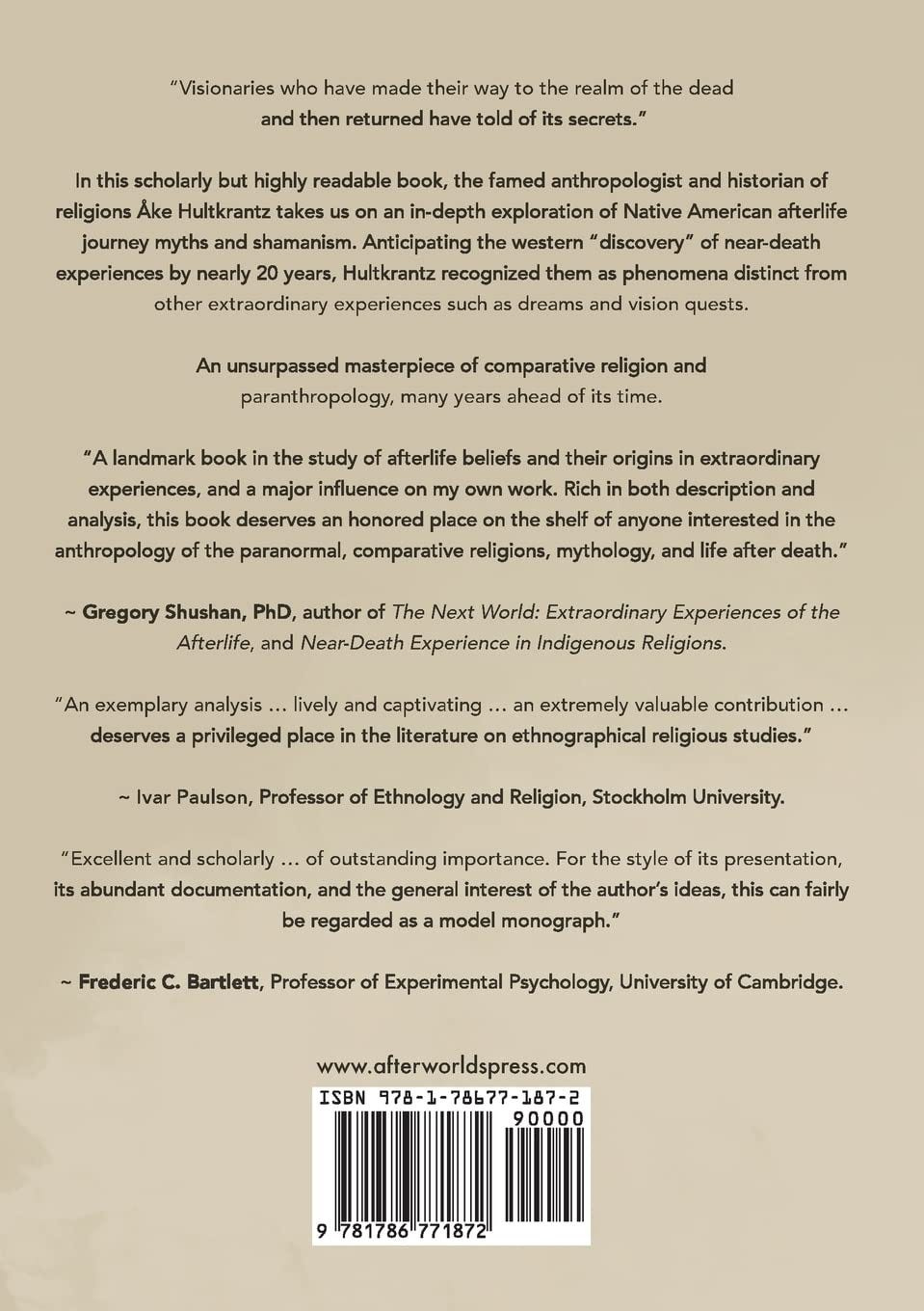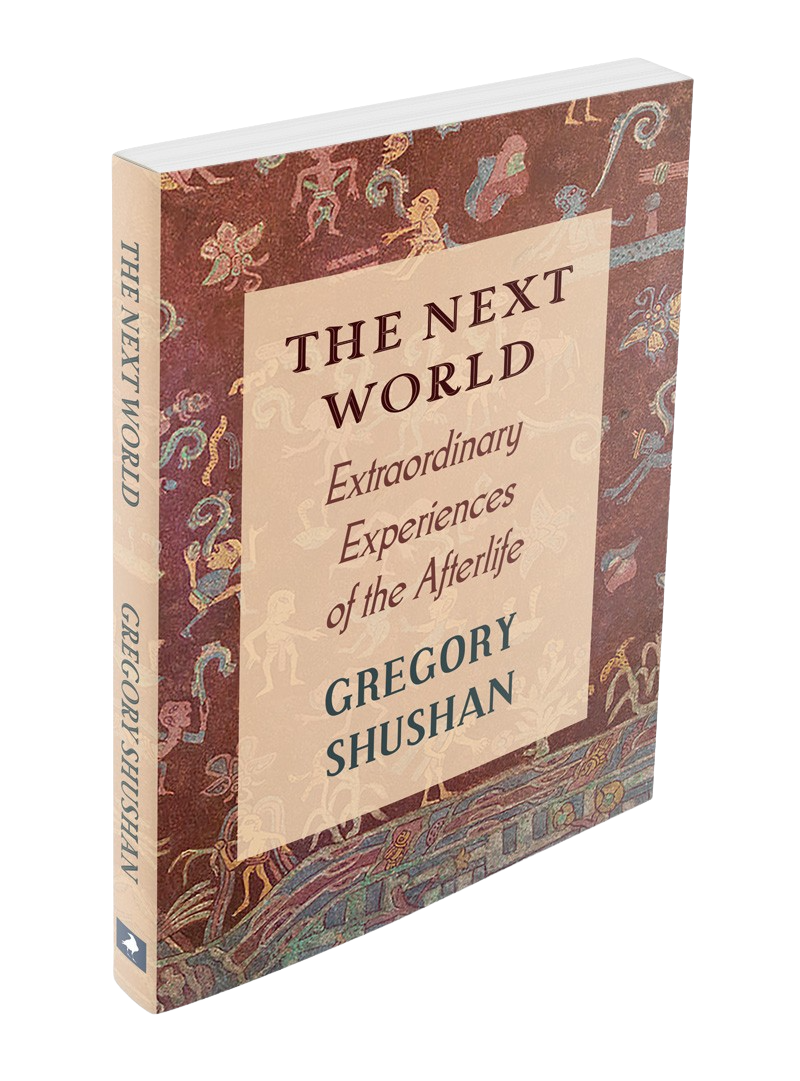Native American Near-Death Experiences, Shamanism, and the Afterlife
This month I’d like to share with you an extended excerpt from a newly reprinted classic in this rarefied field: The North American Indian Orpheus Tradition: Native Afterlife Myths and Their Origins by Åke Hultkrantz. This excerpt summarizes Hultkrantz’s thinking on the relationship between these kinds of extraordinary phenomena and beliefs in an afterlife — and he gives numerous examples of accounts. Keep in mind that this book was written in 1957 — long the modern “discovery” of near-death experiences and their cementing within the popular consciousness.
This is the first book from Afterworlds Press — a new imprint of White Crow Books (publisher of my new book The Next World: Extraordinary Experiences of the Afterlife). I’m the editor for this exciting new labor of love, which will allow me to publish all manner of interesting books on NDEs, the afterlife, and related subjects.
Hultkrantz’s work — and this book in particular — has been an inspiration to my own for many years. When I was first asked to become a commissioning editor for White Crow, this was the very first book I thought of reprinting and I was very fortunate to be able to do so.
So without further ado….
It is rather rare for a person in normal sleep to have a dream experience of a journey to the other world. Dream-journeys are not uncommon, but their goal is for the most part within the frame of the natural world. Hallowell, for instance, testifies that among the Saulteaux he did not hear “any personal accounts of the journey of the soul of a perfectly healthy man to the land of the dead while he was asleep.” Only under certain circumstances — often in connection with illness or painful states of a mental or physical kind — does the soul glide into the way to the land of the dead. Thus of the Thompson Indians it has been said that: “When a person dreams, his soul leaves the body, and walks around the earth. The soul of a person who has the nightmare is nearing the beginning of the trail leading to the world of the souls.”
In unhappy circumstances the soul may go astray on its dream excursion and land up in the realm of the dead. The result is then seldom slow in manifesting itself. The Cocopa Indians who reach the abode of the dead in dreams are exhorted by the dead not to return, but to stay there to escape the hunger and difficulties of this world. But the consequence of such a dream is that the dreamer falls ill. Feverish Ojibway and Creek Indians may while in the state of delirium journey to the other world. In fortunate cases the dreamers are turned away in time by the dead who confront them or hasten towards them. Father Boscana tells of a feverish Juaneño woman who arrived in the land of the dead in dream. She was sent back to life, however, on orders from the ruler of the afterworld; “the woman could not live with them [the dead] yet.”
When in a dream experience a sick Saulteaux Indian approached the village of the dead “he could hear the voices of people shouting and laughing. But someone met him on the road and ordered him back. ‘You’re not wanted yet,’ he was told.” One who does not want to risk illness or even death can as a rule not venture on a visit to the realm of the dead — unless he is a medicine-man. The Wailaki shamans, for example, frequently visited the land of the dead in their dreams; they were careful not to eat anything there, and were then able to return safely.
It is probably in general the case, as Hallowell found among his Saulteaux, that healthy persons may very well approach the realm of the dead, but they can scarcely visit it. Feverish persons, on the other hand, may betake themselves thither, with the risk of being unable to return, while shamans, by taking care, may freely betake themselves thither and home again. From this it is obvious that if the Orpheus tradition is based upon a normal dream experience during sleep, only a shaman’s experiences can come into the question. It appears quite improbable that the source of the tradition should be visions of fever; Orpheus’ rôle is not that of the sick person, rather that of the physician.
A similar objection may be raised against every attempt to build up the Orpheus tradition on the visionary experiences of sick persons in comatose states. One may otherwise with advantage compare Orpheus’ state after his vigil, fasting and exhaustion on account of his grief at the decease of his spouse with those sick persons who in an unconscious state visit the realm of the dead through their extra-corporeal soul. How close is not the introductory section of the Orpheus tales to the following narrative of events communicated by a Saulteaux Indian: “I saw a man who died and lay dead for two days. He told me what had happened to him. He never felt any pain. He thought he was going to sleep. Then, ‘all of a sudden,’ he said, ‘I found myself walking on a good road’.” The road here referred to is of course the road to the other world. Although unconsciousness and the therewith connected low vital activity is considered much more serious than fever, it is not believed necessarily to entail the soul’s straying all the way to the realm of the dead — it may check itself before it gets there.
As a rule, however, the free-soul does in this case actually land up in the other world. Among the Omaha, for example, we are told that “a person who during illness, or from some other cause, falls into a swoon is supposed to pass into the world of spirits.” Sometimes the person who had reached the realm of the dead and who had sojourned there for a time was nevertheless able to return — this might be due to the fact that the person in question was fetched by a shaman, or it might be due to his having been maltreated in the spirit world or turned away by the dead. But it was generally regarded as something extremely serious for someone in a coma to arrive in the realm of the dead: the longer the free-soul sojourned there, the greater was the risk that also the life-soul would leave the body, and the person would herewith be dead.
In many cases the sick person is in a state of such profound lethargy that he appears to be lifeless. This is why many Indian tribes have not made any verbal distinction between complete unconsciousness and death. One hears of people who have “died” and returned to life. Lowie’s informants among the Crow concluded tales of such events with phrases like “he was eager to go back to the dead again and died once more soon after,” “after this experience he did not die again until relatively recently.” Of a Tlingit Indian we are told that he “died and came to life again four times, after which the war spear was taken from him and he died for good.” Owing to the fact that the weakened respiratory and cardiac activity was not always realized by the bystanders, a sick person has in many cases been buried before he has actually died. In fortunate cases he has later, with or without the help of others, been freed from his grave. He has herewith risen from the dead. But also the return of consciousness to the unconscious person is interpreted as such a rising from the dead.
In the Orpheus tradition Orpheus is represented as living, never as dead (we make an exception here for the Lipan tradition), and certainly never as a person whose condition borders upon death-as already mentioned, Orpheus is described not as a passive weakling but as an active hero. If he finally dies, his mission has therewith proved a failure. Thus the Orpheus tradition may in no circumstances be based upon the experiences a sick person has had in the state of deep coma. From this it also follows that the description of Orpheus’ experiences as motivated by grief, exhaustion and so forth cannot be prototypical but must constitute an elaboration of the original narrative — even if an elaboration that is based upon direct psychic experiences of the kind indicated.
The figure of Eurydice, on the other hand, appears in a clearer light if her state in the tradition is defined as deep coma, tantamount to or understood as “death.” We may add that she has in all probability been in a state of “suspended animation”, though it is less certain whether in the older form of the tradition she was also represented as buried the burial episode undoubtedly has its origin, as we shall soon find, in a ritual practice reminiscent of the burial form, which was probably made the object of a later, modifying elaboration. If the original Eurydice was only deeply unconscious or in a state of suspended animation, her resuscitation to life should not have been an impossible enterprise.
As regards Orpheus himself, there then remains the possibility that he was sunk in a shamanistic trance that he was, accordingly, a medicine-man, a shaman. For the shaman, the miracle-worker of the hunting society, its physician and mediator between men and the supernatural powers, the trance constitutes an adequate means of bringing about contact with these powers: during the trance his soul, liberated from the body, undertakes extensive journeys in the supernatural world in order to get the advice of the spirits, to acquire knowledge of hidden matters, to explore the future or restore the escaped or ravished souls of sick persons. The trance can not be compared with ordinary comatose states. In its genuine form it is a psychogenic, hysteroid mode of reaction forming itself according to the dictates of the mind. It may also be described as a mentally anormal state of introversion which may be provoked suggestively or with suggestively acting artificial means (drugs, narcotics etc.), and which is an expression for the conscious or unconscious desires of the visionary. The trance states may be of varying quality and intensity, from light trance to deep trance with amnesia — which is practically tantamount to complete unconsciousness but the different types may gradually merge into each other. Thus the trance may be so deep that it may be compared to a state of death. But it is only rarely represented as equivalent to real death. For in a primitive community everyone knows that the shaman sunk in trance is on a journey; however deathlike he may appear as he lies in his heavy absence, his return is nevertheless expected.
To pay a visit to the realm of the dead of one’s own accord is a great feat, as Hallowell stresses in his splendid analysis of the Saulteaux’ relation to the dead: to visit the land of shades “is very dangerous, if one wishes to return to the land of the living; so only persons with extra ordinary spiritual powers could achieve the journey.” In other words, only the shaman, with his guardian spirits, can perform the feat, and the trance is the appropriate means for this. Innumerable are the reports from North America telling how on his own initiative the shaman has undertaken long journeys in the supernatural world, which is closed for ordinary mortal eyes. When the object of these journeys has been to catch up the escaping soul of a sick person, their ultimate goal has generally been the realm of the dead. Such journeys might be undertaken on several occasions by one and the same person. Thus we are told of a Shuswap prophetess that she “could fall into a trance and go to the land of souls whenever she desired.”
From The North American Indian Orpheus Tradition: Native Afterlife Myths and Their Origins by Åke Hultkrantz (1957; reprinted 2022 by Afterworlds Press), pp. 233–237.
If you enjoyed this except, visit my website www.gregoryshushan.com. And check out my new book from White Crow, The Next World: Extraordinary Experiences of the Afterlife.








